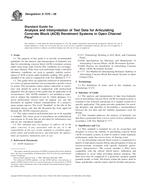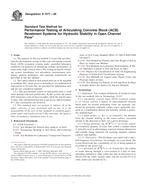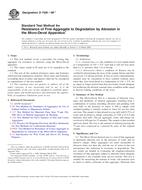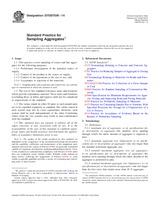Potrebujeme váš súhlas na využitie jednotlivých dát, aby sa vám okrem iného mohli ukazovať informácie týkajúce sa vašich záujmov. Súhlas udelíte kliknutím na tlačidlo „OK“.
ASTM C1740-10
Standard Practice for Evaluating the Condition of Concrete Plates Using the Impulse-Response Method
Automaticky preložený názov:
Štandardné praktiky pre hodnotenie stavu betónových dosiek pomocou metódy Impulse-Response
NORMA vydaná dňa 15.12.2010
Informácie o norme:
Označenie normy: ASTM C1740-10
Poznámka: NEPLATNÁ
Dátum vydania normy: 15.12.2010
Kód tovaru: NS-12348
Počet strán: 10
Približná hmotnosť: 30 g (0.07 libier)
Krajina: Americká technická norma
Kategória: Technické normy ASTM
Kategórie - podobné normy:
Anotácia textu normy ASTM C1740-10 :
Keywords:
concrete plate, dynamic mobility, dynamic stiffness, impulse response, nondestructive testing, ICS Number Code 91.100.30 (Concrete and concrete products)
Doplňujúce informácie
| Significance and Use | ||||||||
|
The impulse-response method is used to evaluate the condition of concrete slabs, pavements, bridge decks, walls, or other concrete plate structures. The method is also applicable to plate structures with overlays, such as concrete bridge decks with asphalt or portland cement concrete overlays. The impulse-response method is intended for rapid screening of structures to identify potential locations of anomalous conditions that require more detailed investigation. This practice is not intended for integrity testing of piles. For such applications refer to Test Method D5882. This practice can be used to locate delaminated or poorly consolidated concrete. It can also be used to locate regions of poor support or voids beneath slabs bearing on ground. Results are used on a comparative basis for comparing concrete quality or support conditions at one point in the tested structural element with conditions at other points in the same element, or for comparing a structural element with another element of the same geometry. Invasive probing (drilling holes or chipping away concrete) or drilling of cores is used to confirm interpretations of impulse-response results. Because concrete properties can vary from point to point in the structure due to differences in concrete age, batch-to-batch variability, or placement and consolidation practices, the measured mobility and dynamic stiffness can vary from point to point in a plate element of constant thickness. Note 1—The flexural stiffness of a plate is directly proportional to the elastic modulus of the material and directly proportional to the thickness raised to the third power (5). As a result, variations in thickness will have a greater effect on variations in mobility than variations in elastic modulus. The effective radius of influence of the hammer blow limits the maximum concrete element thickness that can be tested. The apparatus defined in this practice is intended for thicknesses less than 1 m. For highway applications, results may be influenced by traffic noise or low frequency structural vibrations set up by normal movement of traffic across a structure. The intermittent nature of these noises, however, may allow testing during traffic flow on adjacent portions of the structure. Engineering judgment is required to determine whether the response has been influenced by traffic-induced vibrations. Heavy loads on suspended slabs may affect test results by altering the frequencies and shapes of different modes of vibration. Debris on the test surface may interfere with obtaining a sharp impact and with measuring the response. The practice is not applicable in the presence of vibrations created by mechanical equipment (jack hammers, sounding with a hammer, mechanical sweepers, and the like) impacting the structure. Tests conducted next to or directly over structural elements that stiffen the plate will result in reduced mobility and not be representative of the internal conditions of the plate. The practice is not applicable in the presence of electrical noise, such as that produced by a generator or other electrical sources, that is captured by the data-acquisition system. |
||||||||
| 1. Scope | ||||||||
|
1.1 This practice provides the procedure for using the impulse-response method to evaluate rapidly the condition of concrete slabs, pavements, bridge decks, walls, or other plate-like structures. 1.2 The values stated in SI units are to be regarded as standard. No other units of measurement are included in this standard. 1.3 This standard does not purport to address all of the safety concerns, if any, associated with its use. It is the responsibility of the user of this standard to establish appropriate safety and health practices and determine the applicability of regulatory limitations prior to use. 1.4 The text of this standard references notes and footnotes that provide explanatory material. These notes and footnotes (excluding those in tables and figures) shall not be considered as requirements of the standard. |
||||||||
| 2. Referenced Documents | ||||||||
|
Podobné normy:
Historická
1.6.2014
Historická
1.6.2011
Historická
1.8.2008
Historická
1.8.2008
Historická
1.2.2008
Historická
1.6.2014



 ASTM D7172-14
ASTM D7172-14 ASTM D7174-05(2011)..
ASTM D7174-05(2011).. ASTM D7276-08
ASTM D7276-08 ASTM D7277-08
ASTM D7277-08 ASTM D7428-08e1
ASTM D7428-08e1 ASTM D75/D75M-14..
ASTM D75/D75M-14..
 Cookies
Cookies
